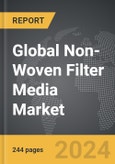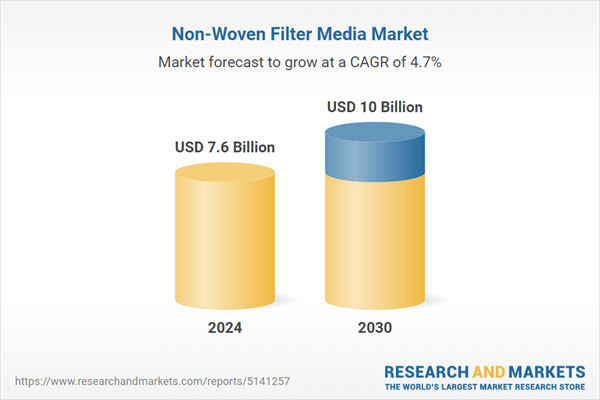The global market for Non-Woven Filter Media was valued at US$7.6 Billion in 2024 and is projected to reach US$10.0 Billion by 2030, growing at a CAGR of 4.7% from 2024 to 2030. This comprehensive report provides an in-depth analysis of market trends, drivers, and forecasts, helping you make informed business decisions. The report includes the most recent global tariff developments and how they impact the Non-Woven Filter Media market.
Segments: Technology (Spunbound, Meltblown, Needlepunch, Other Technologies); End-Use (Healthcare, Food & Beverage, Transportation, Water Filtration, HVAC, Manufacturing, Other End-Uses).
Geographic Regions/Countries: World; United States; Canada; Japan; China; Europe (France; Germany; Italy; United Kingdom; Spain; Russia; and Rest of Europe); Asia-Pacific (Australia; India; South Korea; and Rest of Asia-Pacific); Latin America (Argentina; Brazil; Mexico; and Rest of Latin America); Middle East (Iran; Israel; Saudi Arabia; United Arab Emirates; and Rest of Middle East); and Africa.
The analysts continuously track trade developments worldwide, drawing insights from leading global economists and over 200 industry and policy institutions, including think tanks, trade organizations, and national economic advisory bodies. This intelligence is integrated into forecasting models to provide timely, data-driven analysis of emerging risks and opportunities.
Global Non-Woven Filter Media Market - Key Trends & Drivers Summarized
What Is Non-Woven Filter Media and Why Is It Crucial for Modern Filtration Applications?
Non-woven filter media are fibrous filtration materials arranged in a random or systematic pattern, bonded by chemical, thermal, or mechanical processes, rather than woven together on a loom. This versatile filtration media offers a balance of functionality, cost-effectiveness, and environmental sustainability, making it integral to numerous applications including automotive, healthcare, water filtration, and HVAC systems. Non-woven materials are praised for their high filtration efficiency, permeability, and ability to capture fine particulates, attributes that are essential in stringent environmental and health safety standards. Their adaptability to various filtration needs - ranging from preliminary to high-efficiency air, fluid, and particulate filtration - reflects their critical role in improving air and water quality in industrial and residential settings.How Are Technological Advancements Enhancing Non-Woven Filter Media?
Innovation in material science and manufacturing technology has significantly broadened the capabilities and applications of non-woven filter media. Developments in fiber technology, such as bi-component fibers and nanofibers, have dramatically improved the performance characteristics of non-woven filters, enabling them to capture sub-micron particles and offering higher durability and efficiency. Additionally, advancements in fabrication techniques like melt-blown, spunbond, and needle-punch processes have optimized the production of non-woven materials, making them more cost-effective and environmentally friendly by reducing waste and energy consumption. These technological enhancements not only extend the lifecycle of the filters but also augment their performance in critical applications such as pollution control and microbial containment.What Trends Are Driving Demand in the Non-Woven Filter Media Market?
Several key trends are currently shaping the demand for non-woven filter media. Environmental regulations and public awareness regarding air and water quality are major drivers, as governments worldwide implement stricter standards to control pollution and protect public health. This regulatory push has accelerated the adoption of sophisticated filtration technologies, particularly in industries like automotive, where emission controls are critical, and in public water systems where safety standards are stringently monitored. Additionally, the global health crisis highlighted by the COVID-19 pandemic has underscored the importance of effective filtration in healthcare settings, driving significant growth in the medical and pharmaceutical sectors. The increasing prevalence of airborne diseases and the rising health concerns related to air quality in urban environments further bolster the need for advanced filtration solutions.What Are the Primary Growth Drivers for the Non-Woven Filter Media Market?
The growth in the non-woven filter media market is driven by several factors, including the heightened global awareness of environmental and health-related issues that necessitate advanced filtration solutions. The increasing demand for efficiency and specificity in filtration across various industries, such as automotive, healthcare, and manufacturing, continues to push the development of high-performance non-woven filter materials. Technological innovations that improve filter performance and sustainability also play a crucial role in market expansion. Economic growth in emerging markets contributes to increased industrial activity and urbanization, which in turn boosts the need for effective filtration to combat pollution and ensure clean air and water. Additionally, consumer behavior that favors eco-friendly and energy-efficient products supports the adoption of non-woven filters, aligning with global sustainability goals. These drivers, combined with ongoing industrial and regulatory developments, ensure a robust growth trajectory for the non-woven filter media industry, making it a key component in global efforts to improve environmental quality and public health.Report Scope
The report analyzes the Non-Woven Filter Media market, presented in terms of units. The analysis covers the key segments and geographic regions outlined below.Segments: Technology (Spunbound, Meltblown, Needlepunch, Other Technologies); End-Use (Healthcare, Food & Beverage, Transportation, Water Filtration, HVAC, Manufacturing, Other End-Uses).
Geographic Regions/Countries: World; United States; Canada; Japan; China; Europe (France; Germany; Italy; United Kingdom; Spain; Russia; and Rest of Europe); Asia-Pacific (Australia; India; South Korea; and Rest of Asia-Pacific); Latin America (Argentina; Brazil; Mexico; and Rest of Latin America); Middle East (Iran; Israel; Saudi Arabia; United Arab Emirates; and Rest of Middle East); and Africa.
Key Insights:
- Market Growth: Understand the significant growth trajectory of the Spunbound segment, which is expected to reach US$4.1 Billion by 2030 with a CAGR of a 5.3%. The Meltblown segment is also set to grow at 4.6% CAGR over the analysis period.
- Regional Analysis: Gain insights into the U.S. market, valued at $2.0 Billion in 2024, and China, forecasted to grow at an impressive 7.2% CAGR to reach $2.2 Billion by 2030. Discover growth trends in other key regions, including Japan, Canada, Germany, and the Asia-Pacific.
Why You Should Buy This Report:
- Detailed Market Analysis: Access a thorough analysis of the Global Non-Woven Filter Media Market, covering all major geographic regions and market segments.
- Competitive Insights: Get an overview of the competitive landscape, including the market presence of major players across different geographies.
- Future Trends and Drivers: Understand the key trends and drivers shaping the future of the Global Non-Woven Filter Media Market.
- Actionable Insights: Benefit from actionable insights that can help you identify new revenue opportunities and make strategic business decisions.
Key Questions Answered:
- How is the Global Non-Woven Filter Media Market expected to evolve by 2030?
- What are the main drivers and restraints affecting the market?
- Which market segments will grow the most over the forecast period?
- How will market shares for different regions and segments change by 2030?
- Who are the leading players in the market, and what are their prospects?
Report Features:
- Comprehensive Market Data: Independent analysis of annual sales and market forecasts in US$ Million from 2024 to 2030.
- In-Depth Regional Analysis: Detailed insights into key markets, including the U.S., China, Japan, Canada, Europe, Asia-Pacific, Latin America, Middle East, and Africa.
- Company Profiles: Coverage of players such as Ahlstrom, Albarrie Canada Limited, Autotech Nonwovens Pvt. Ltd., Berry Global, Inc., Cummins Filtration and more.
- Complimentary Updates: Receive free report updates for one year to keep you informed of the latest market developments.
Some of the 41 companies featured in this Non-Woven Filter Media market report include:
- Ahlstrom
- Albarrie Canada Limited
- Autotech Nonwovens Pvt. Ltd.
- Berry Global, Inc.
- Cummins Filtration
- Enviroconcepts International Pty Limited
- Fluid Systems
- Great Lakes Filters
- Huzhou Yaojin Nonwoven Technology Co., Ltd.
- JSC Komitex
Tariff Impact Analysis: Key Insights for 2025
Global tariff negotiations across 180+ countries are reshaping supply chains, costs, and competitiveness. This report reflects the latest developments as of April 2025 and incorporates forward-looking insights into the market outlook.The analysts continuously track trade developments worldwide, drawing insights from leading global economists and over 200 industry and policy institutions, including think tanks, trade organizations, and national economic advisory bodies. This intelligence is integrated into forecasting models to provide timely, data-driven analysis of emerging risks and opportunities.
What’s Included in This Edition:
- Tariff-adjusted market forecasts by region and segment
- Analysis of cost and supply chain implications by sourcing and trade exposure
- Strategic insights into geographic shifts
Buyers receive a free July 2025 update with:
- Finalized tariff impacts and new trade agreement effects
- Updated projections reflecting global sourcing and cost shifts
- Expanded country-specific coverage across the industry
Table of Contents
I. METHODOLOGYII. EXECUTIVE SUMMARY2. FOCUS ON SELECT PLAYERSIII. MARKET ANALYSISCANADAITALYSPAINRUSSIAREST OF EUROPESOUTH KOREAREST OF ASIA-PACIFICARGENTINABRAZILMEXICOREST OF LATIN AMERICAIRANISRAELSAUDI ARABIAUNITED ARAB EMIRATESREST OF MIDDLE EASTIV. COMPETITION
1. MARKET OVERVIEW
3. MARKET TRENDS & DRIVERS
4. GLOBAL MARKET PERSPECTIVE
UNITED STATES
JAPAN
CHINA
EUROPE
FRANCE
GERMANY
UNITED KINGDOM
ASIA-PACIFIC
AUSTRALIA
INDIA
LATIN AMERICA
MIDDLE EAST
AFRICA
Companies Mentioned (Partial List)
A selection of companies mentioned in this report includes, but is not limited to:
- Ahlstrom
- Albarrie Canada Limited
- Autotech Nonwovens Pvt. Ltd.
- Berry Global, Inc.
- Cummins Filtration
- Enviroconcepts International Pty Limited
- Fluid Systems
- Great Lakes Filters
- Huzhou Yaojin Nonwoven Technology Co., Ltd.
- JSC Komitex
Table Information
| Report Attribute | Details |
|---|---|
| No. of Pages | 244 |
| Published | April 2025 |
| Forecast Period | 2024 - 2030 |
| Estimated Market Value ( USD | $ 7.6 Billion |
| Forecasted Market Value ( USD | $ 10 Billion |
| Compound Annual Growth Rate | 4.7% |
| Regions Covered | Global |







![Laboratory Filtration Market by Product (Filters [Membrane Filter, Depth Filter], Media, Assemblies, Accessories), Material (PES, PVDF, Nylon, PTFE), Technique (Ultrafiltration, Microfiltration, Nanofiltration, Reverse Osmosis) - Forecast to 2029 - Product Image](http://www.researchandmarkets.com/product_images/11867/11867105_60px_jpg/laboratory_filtration_market.jpg)

